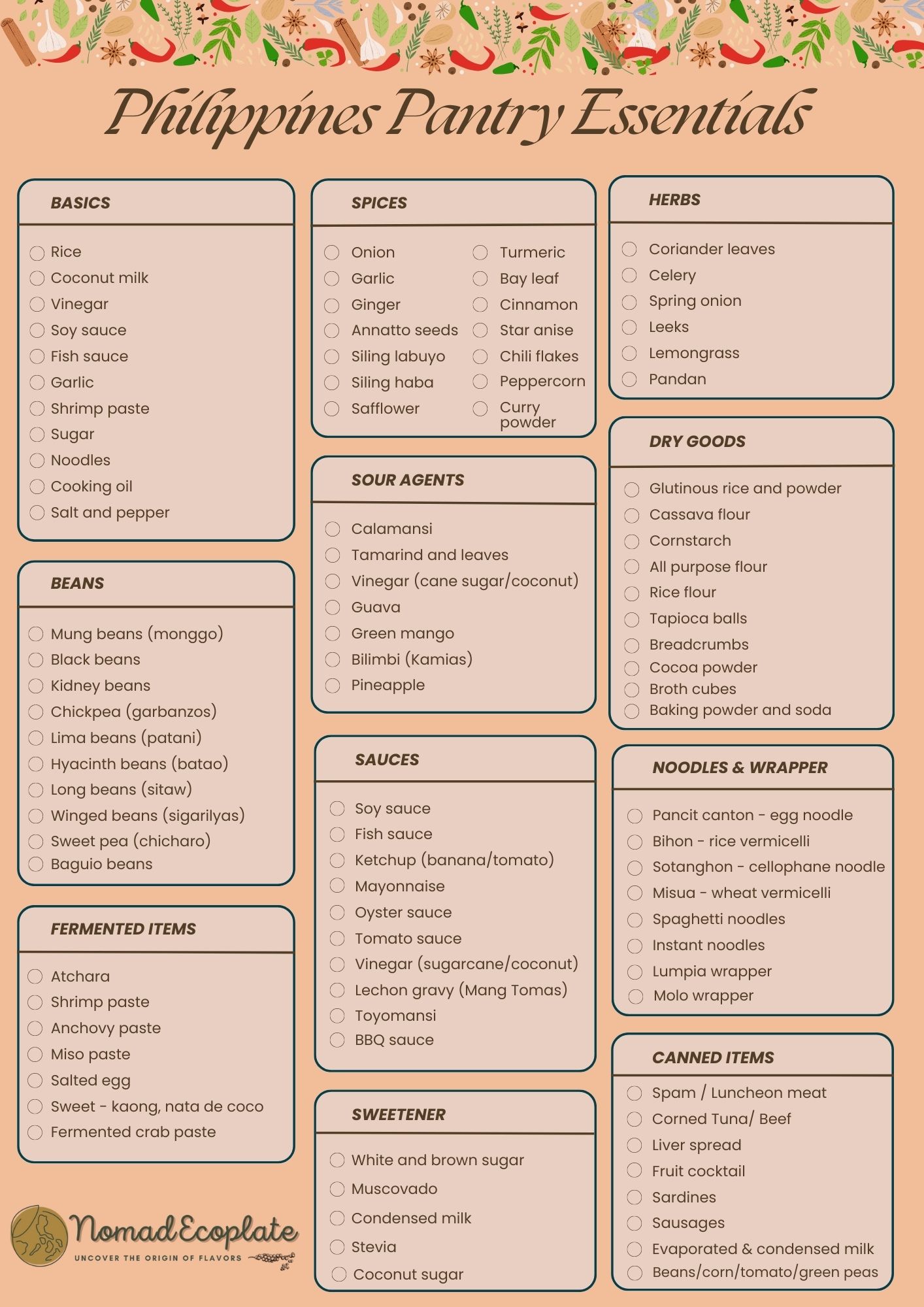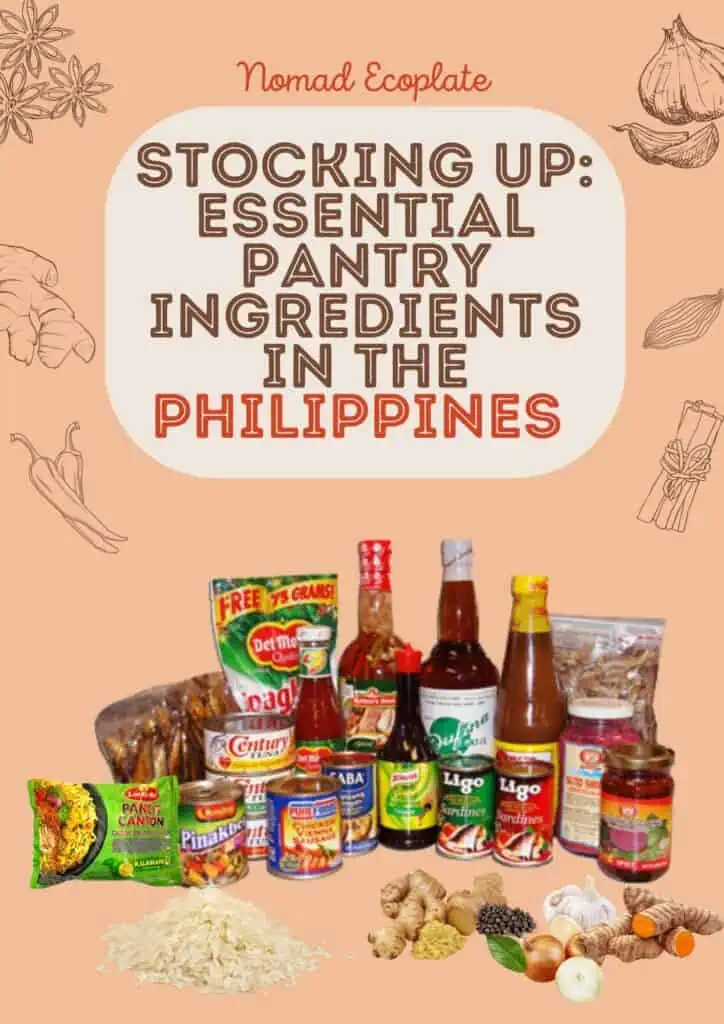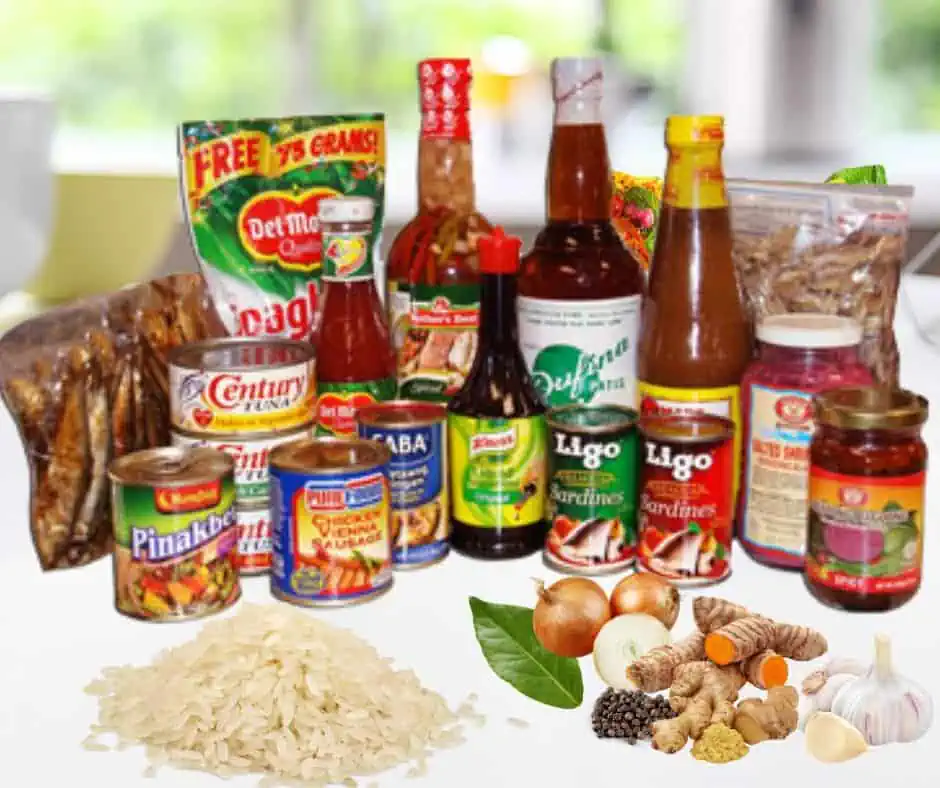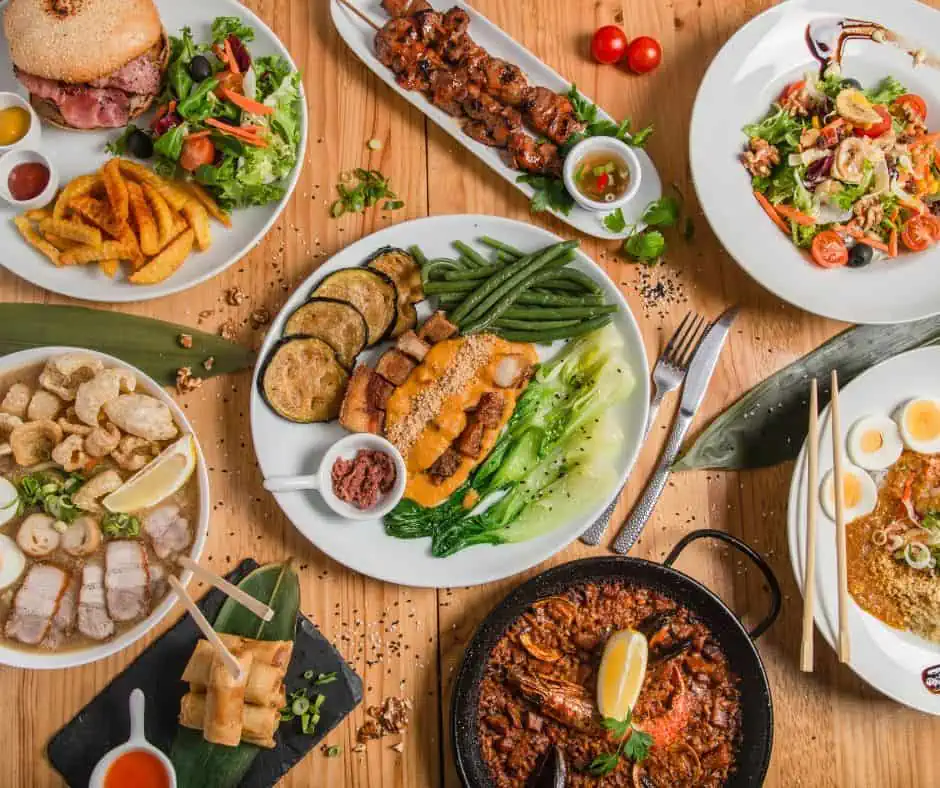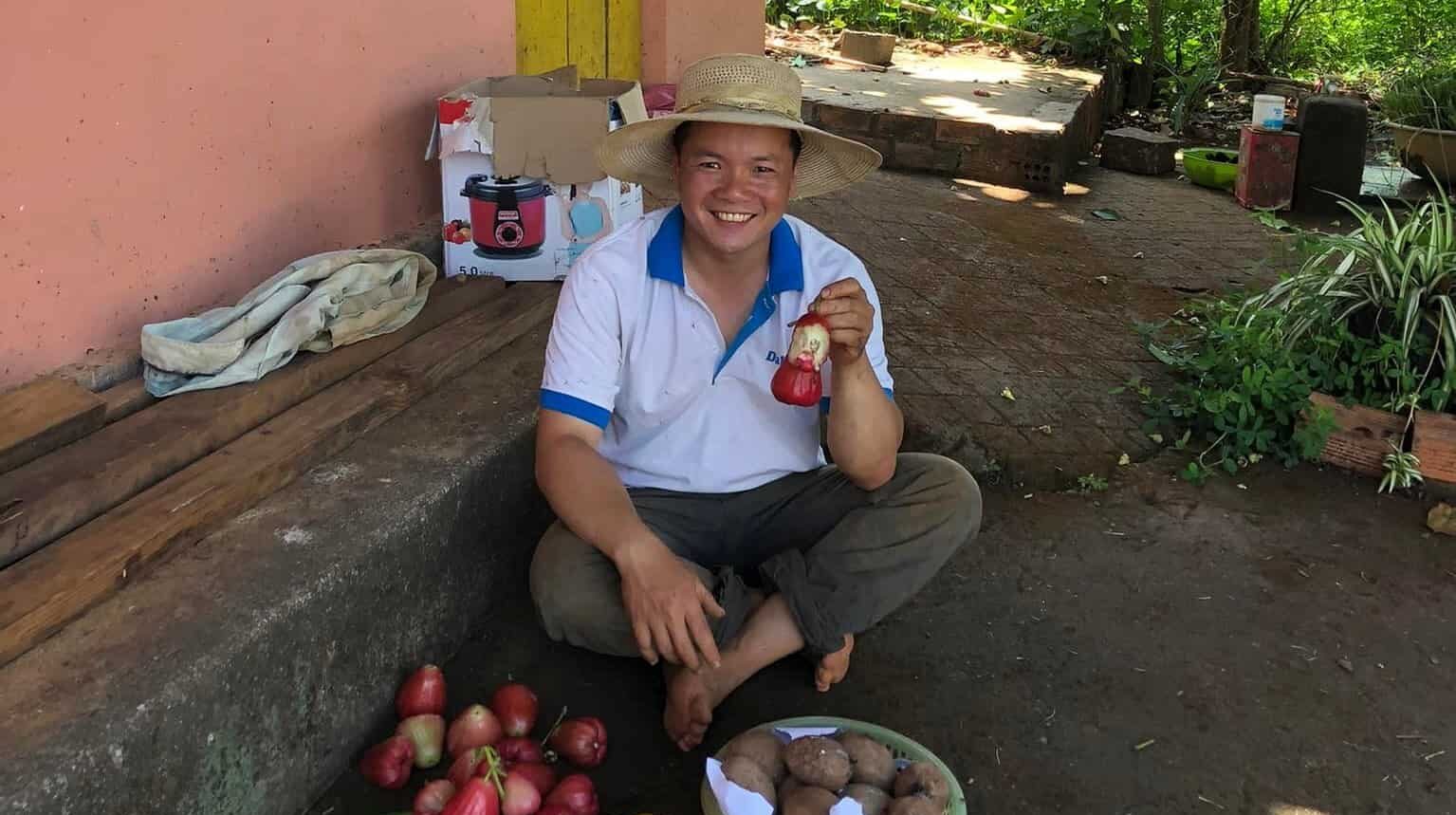Introduction
Are you planning to cook a delicious Filipino dish soon? Unsure about the authentic Filipino pantry ingredients you need for that perfect taste? As a Filipino traveler, I’ve often found myself searching for Filipino communities abroad, seeking out authentic ingredients to recreate the flavors of home. If you’re curious to learn more about the pantry ingredients that make Filipino cuisine come alive, you’re in the right place!
In the culinary world, pantry essentials play a crucial role in crafting flavorful and authentic dishes. They are the foundation of various cuisines, and Filipino cuisine is no exception. With its rich blend of indigenous, Spanish, Chinese, and American influences, Filipino cooking relies on a well-stocked pantry of unique ingredients that truly capture its essence.
These pantry ingredients not only add depth and complexity to dishes but also reflect the cultural heritage and culinary traditions of the Philippines.
In this blog, we will dig deep into the “must-have” pantry ingredients specific to the Philippines. From aromatic spices and seasonings to indigenous elements and traditional condiments, each ingredient contributes to the distinct flavors and character that define Filipino dishes.
Join me on this culinary journey as we explore the significance of these pantry ingredients and gain insights into their role in crafting delicious Filipino dishes.
A Must-Have Pantry Ingredients
1. Rice: The Staple of Filipino Cuisine
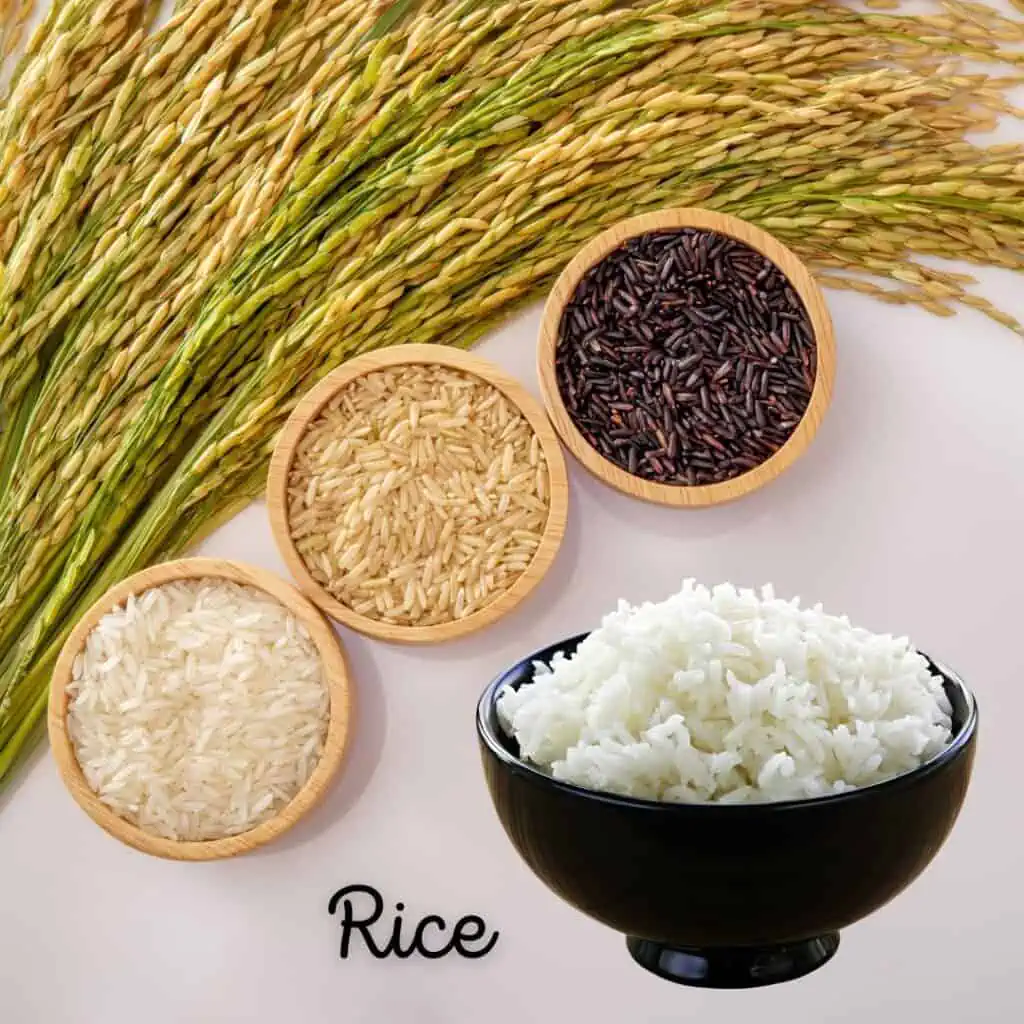
Rice or Kanin is the heart and soul of Filipino cuisine. It is the foundation of many Filipino dishes and is often served alongside flavorful viands. The Philippines is known for its wide variety of rice, from fragrant jasmine rice to sticky glutinous rice. Stocking up on different types of rice ensures that you have the perfect base for any Filipino meal.
Popular local rice: Dinorado, Japonica Premium, Premium Sinandomeng
Best Alternative for Diabetics: Adlai rice, Quinoa, Colored rice (brown, red or black), Plantain or Saba, Sweet potato
Pro Tip:
To add extra flavor to your rice, try cooking it with pandan leaves or garlic. The aroma will be irresistible!
2. Coconut Milk: Creamy and Flavorful
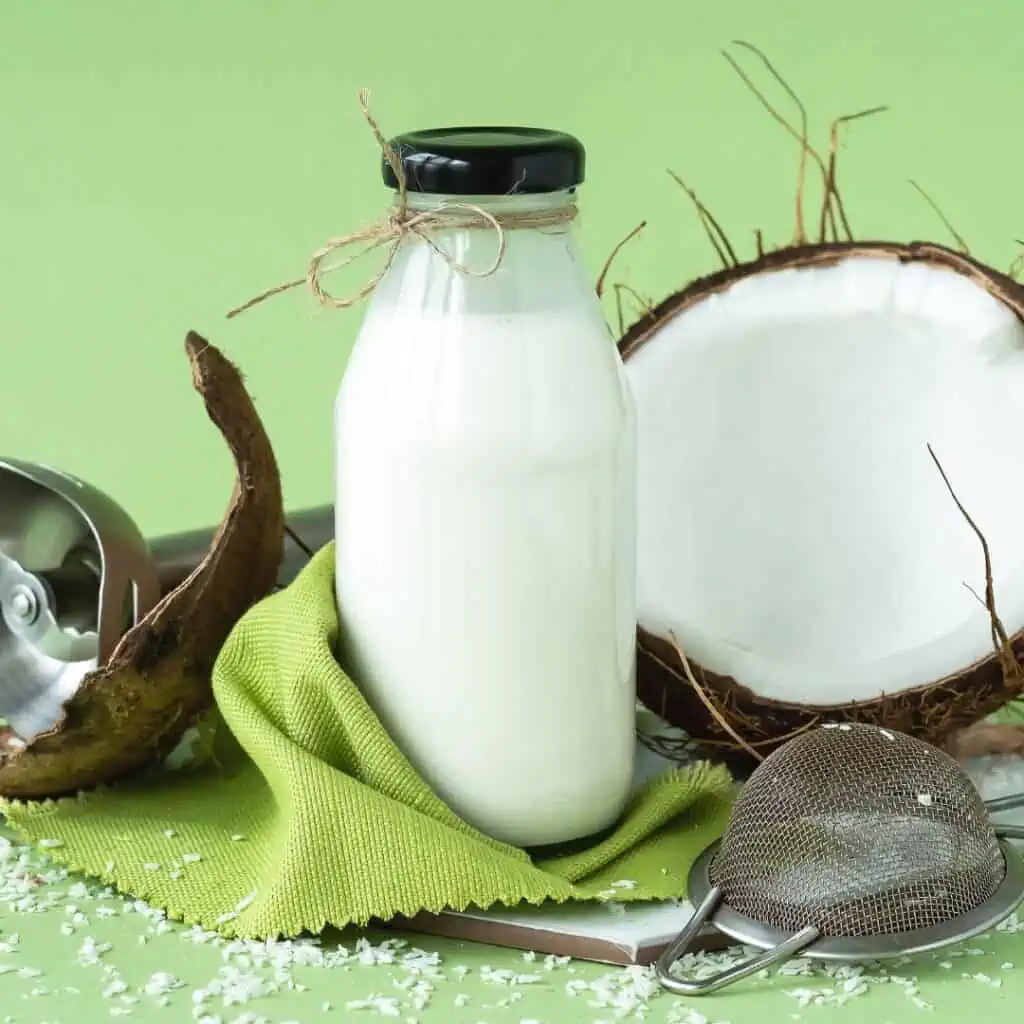
Coconut milk, also called as Gata in Tagalog is a key ingredient in many Filipino dishes, adding richness and depth of flavor. It is made by grating the flesh of mature coconuts and extracting the creamy liquid.
Coconut milk is commonly used in dishes like kare-kare, laing, chicken curry, and ginataang gulay (vegetables cooked in coconut milk). For sweet desserts such as ginataang bilo-bilo, Biko, ube halaya, cassava cake, and ginataang mais.
Did You Know?
Coconut milk is not only delicious but also packed with nutrients. It contains vitamins C, E, B1, B3, B5, and B6, as well as minerals like iron, selenium, sodium, calcium, and magnesium.
3. Vinegar: The Filipino Souring Agent
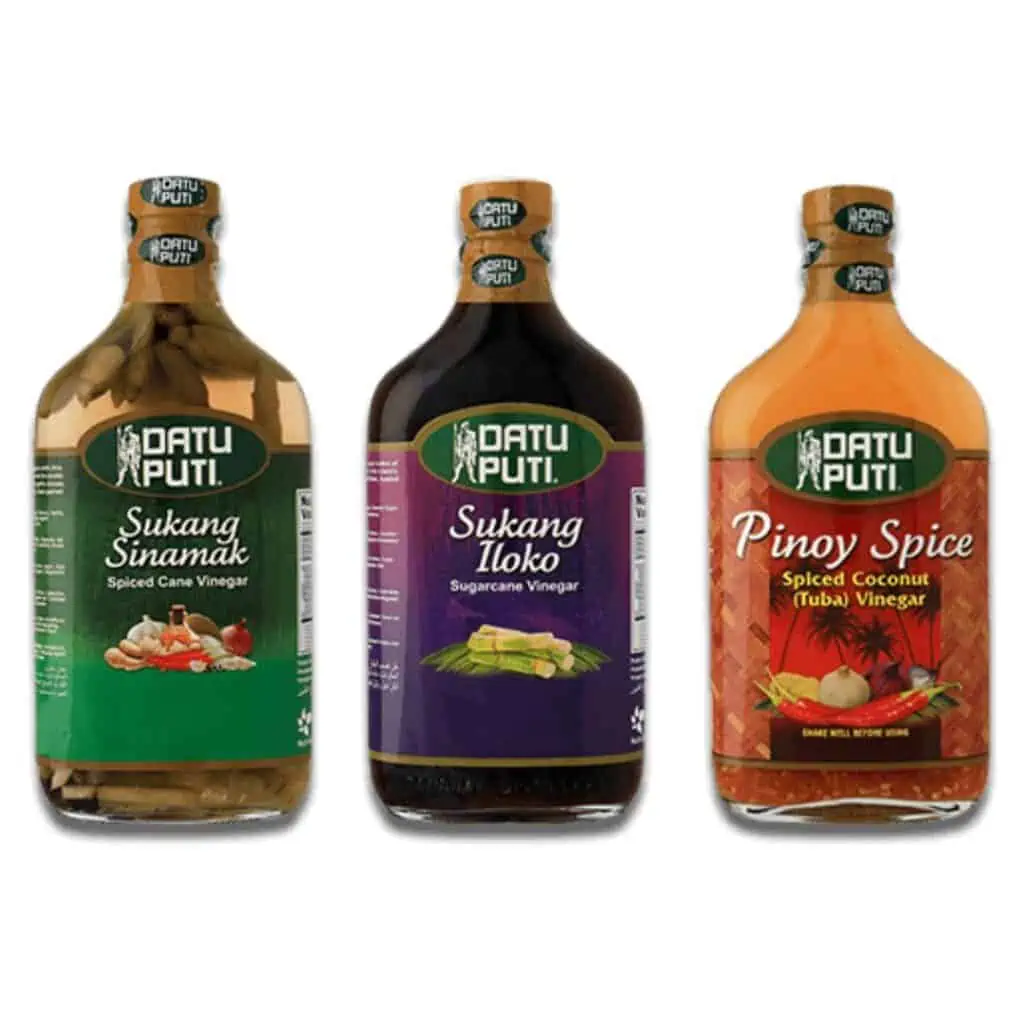
Vinegar, also called as Suka in Tagalog is a staple condiment in Filipino cuisine, providing a tangy and acidic flavor to many dishes. Sukang Maasim, a type of cane vinegar, is commonly used in adobo, one of the Philippines’ most iconic dishes. It balances the richness of meat and adds a delightful sour note.
One of the popular brands of vinegar in the Philippines is Datu Puti [1]
Fun Fact:
In the Philippines, there are various types of vinegar available, including coconut vinegar, sugar cane vinegar, and palm vinegar. Each type offers a unique flavor profile, so don’t be afraid to experiment!
4. Soy Sauce: The Umami Enhancer
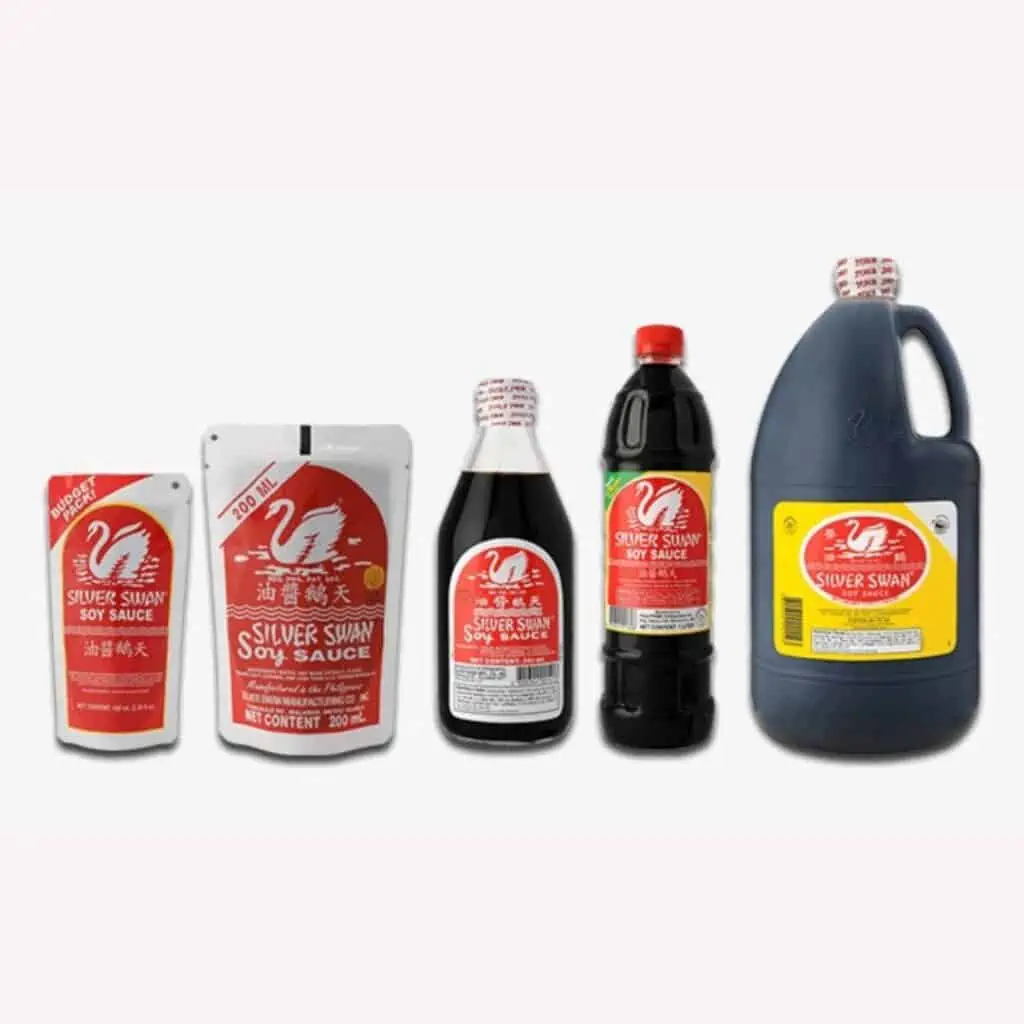
Soy sauce or Toyo is an indispensable ingredient in Filipino cooking. It adds depth and umami to dishes like adobo, pancit, and bistek. Filipino soy sauce is typically darker and sweeter than its Chinese counterparts, making it a distinct flavor in Filipino cuisine.
Popular local brands: Silver Swan, Marca Pina, Datu Puti
Best alternative for lower sodium: Coconut Aminos, Bragg Liquid Aminos, Tamari, Wan Ja Shan organic soy sauce, Shoyu
Pro Tip:
To elevate the flavor of your dishes, try using premium soy sauce like the locally produced Datu Puti Soy Sauce. Its rich and savory taste will take your Filipino recipes to the next level.
5. Fish Sauce: The Secret Ingredient
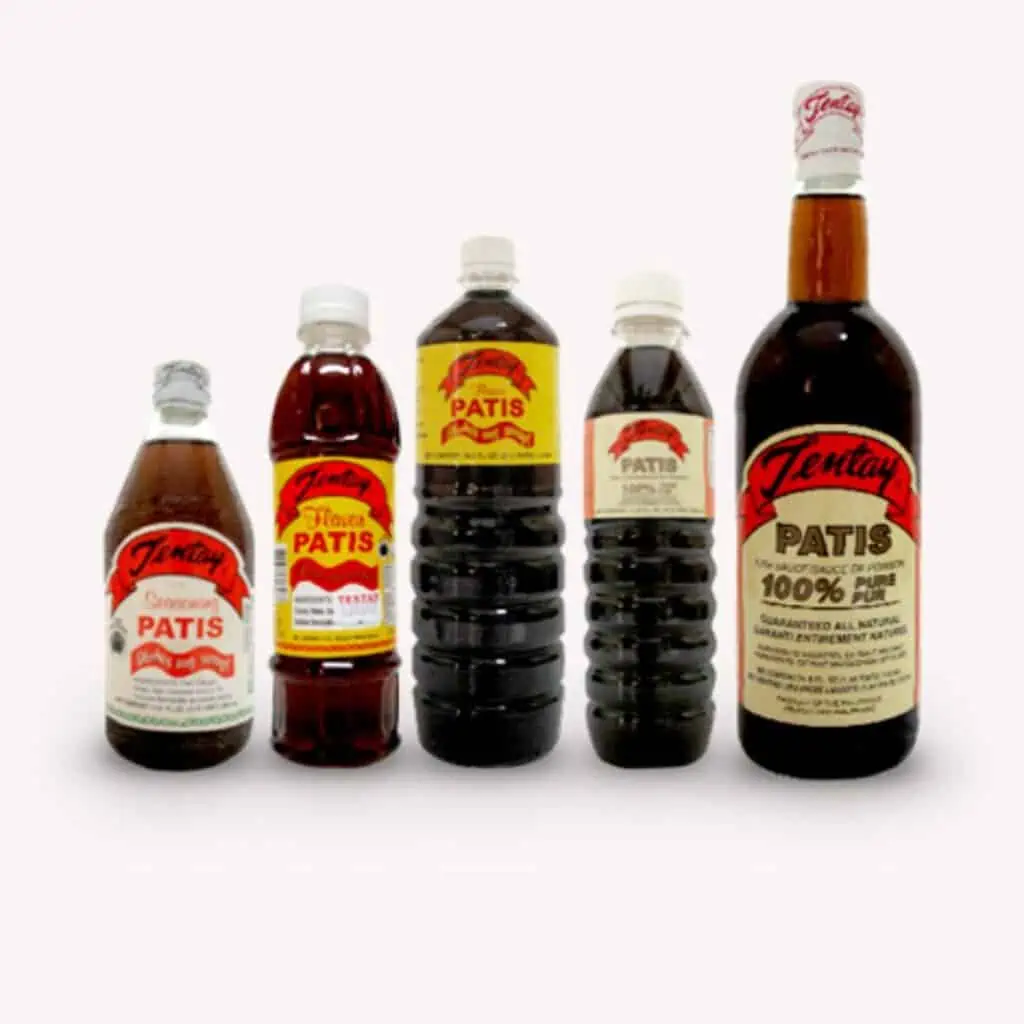
Fish sauce, or patis, is a pungent condiment made from fermented fish. It is used as a flavor enhancer in many Filipino dishes, providing a savory and salty taste. Fish sauce is a crucial component of dishes like sinigang, tinola, lugaw, and nilaga.
Popular local brands: Datu Puti, Lorins, Silver Swan, Tentay, Tiparos
Best alternative brands for Vegans: 24 Vegan, Squid, Wholesome Provisions, Ocean’s Halo
Did You Know?
Fish sauce is a popular ingredient not only in the Philippines but also in other Southeast Asian cuisines like Thai and Vietnamese. It adds a distinct umami flavor to dishes across the region.
6. Garlic: The Aromatic Powerhouse
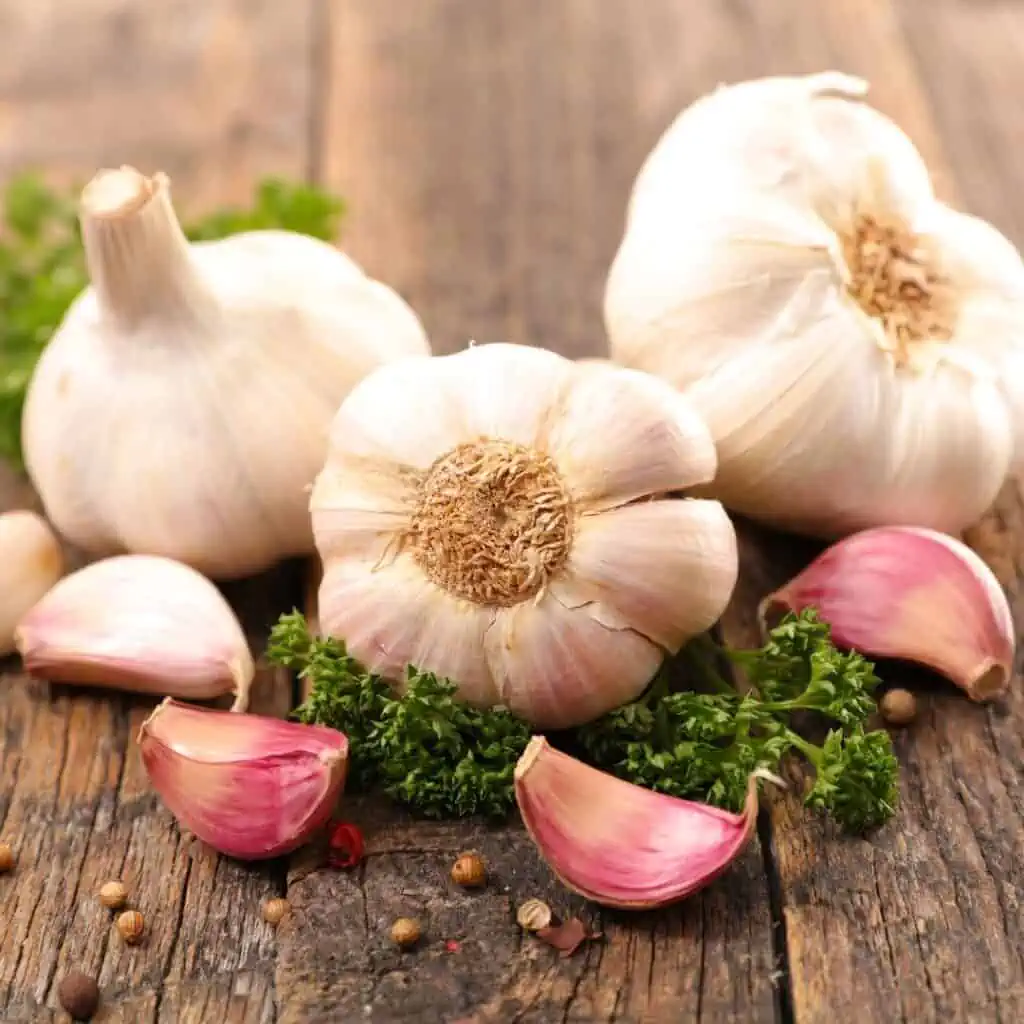
Garlic or Bawang is a kitchen staple in the Philippines. Its pungent aroma and robust flavor are essential in countless Filipino recipes. Whether sautéed, minced, or crushed, garlic adds a delightful kick to dishes like Sinangag, Sisig, Arroz caldo, Monggo, and Adobo.
Fun Fact:
In Filipino folklore, garlic is believed to ward off evil spirits. So not only does it add flavor to your dishes, but it also brings good luck!
7. Shrimp Paste or Bagoong: A Flavorful Condiment
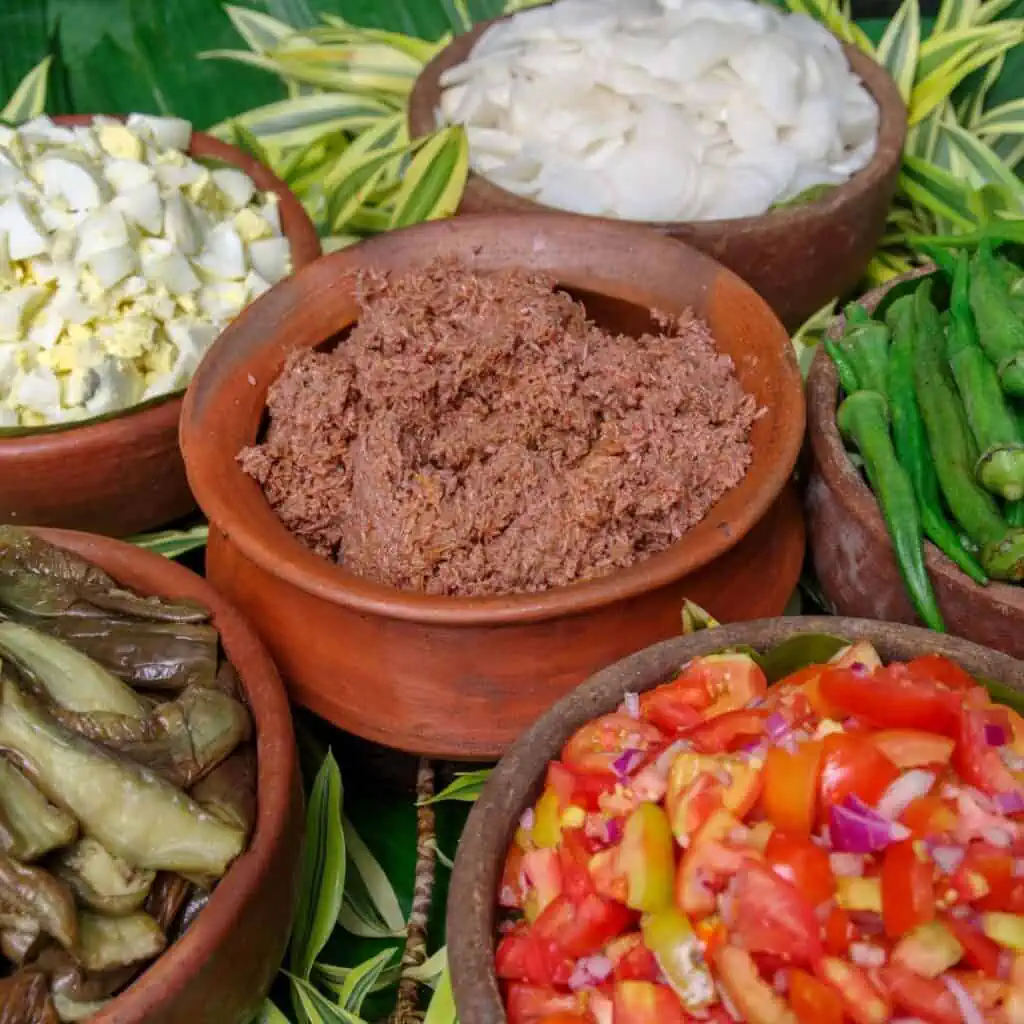
Shrimp paste, known as bagoong, is a popular condiment in Filipino cuisine. It is made from fermented shrimp and is used to add a savory and briny taste to various dishes. Bagoong is often enjoyed with green mangoes or singkamas or used as an ingredient in dishes like kare-kare, Pinakbet, and binagoongan.
Popular local shrimp paste brand: Barrio Fiesta, Kamayan, Pangasinan, Dagupan, Buenas, Kapuso
Alternative to Shrimp paste for Vegans: Fermented Chinese Black beans, Miso paste, Dried Shiitake, Seaweed, Vegan fish sauce, Fermented bean paste/ Doenjang
Pro Tip:
When buying shrimp paste, opt for the bottled or jarred varieties that are readily available in stores. They offer convenience and can be easily incorporated into your cooking.
8. Annatto Seeds: Adding Color and Flavor
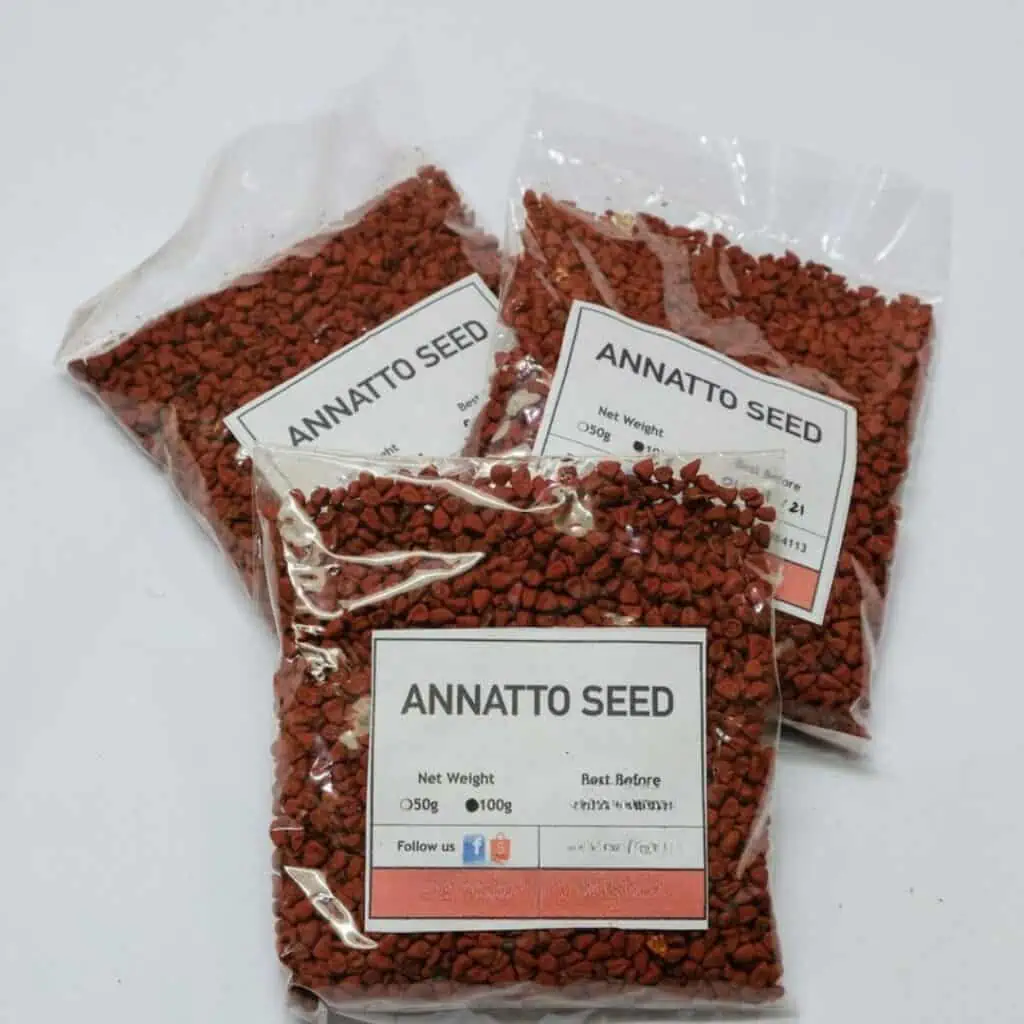
Annatto seeds, also known as achuete or atsuete, are small reddish seeds that are used as a natural food coloring agent in Filipino cuisine. It is also called “Lipstick tree” in other countries. They provide a vibrant orange hue to dishes like kare-kare, Chicken inasal, and pancit malabon. Annatto seeds also impart a subtle nutty flavor to the dishes they are used in.
How to make Annatto oil?
2 cups vegetable oil
½ cup achuete (annatto) seeds
6 whole garlic cloves
2 bay leaves
2 ancho chiles, crushed, stemmed, and seeded
In a medium saucepan, heat the oil along with the rest of the ingredients over medium heat. Once it starts to bubble, turn off the heat and let the mixture steep for a minimum of 1 hour or a maximum of 2 hours. Afterward, strain the oil through a fine-mesh strainer and allow it to cool. Transfer the oil to an airtight container and store it in the refrigerator.
Did You Know?
Apart from its culinary uses, annatto seeds are also used in traditional medicine for their potential antioxidant and anti-inflammatory properties.
9. Noodles: A Versatile Ingredient
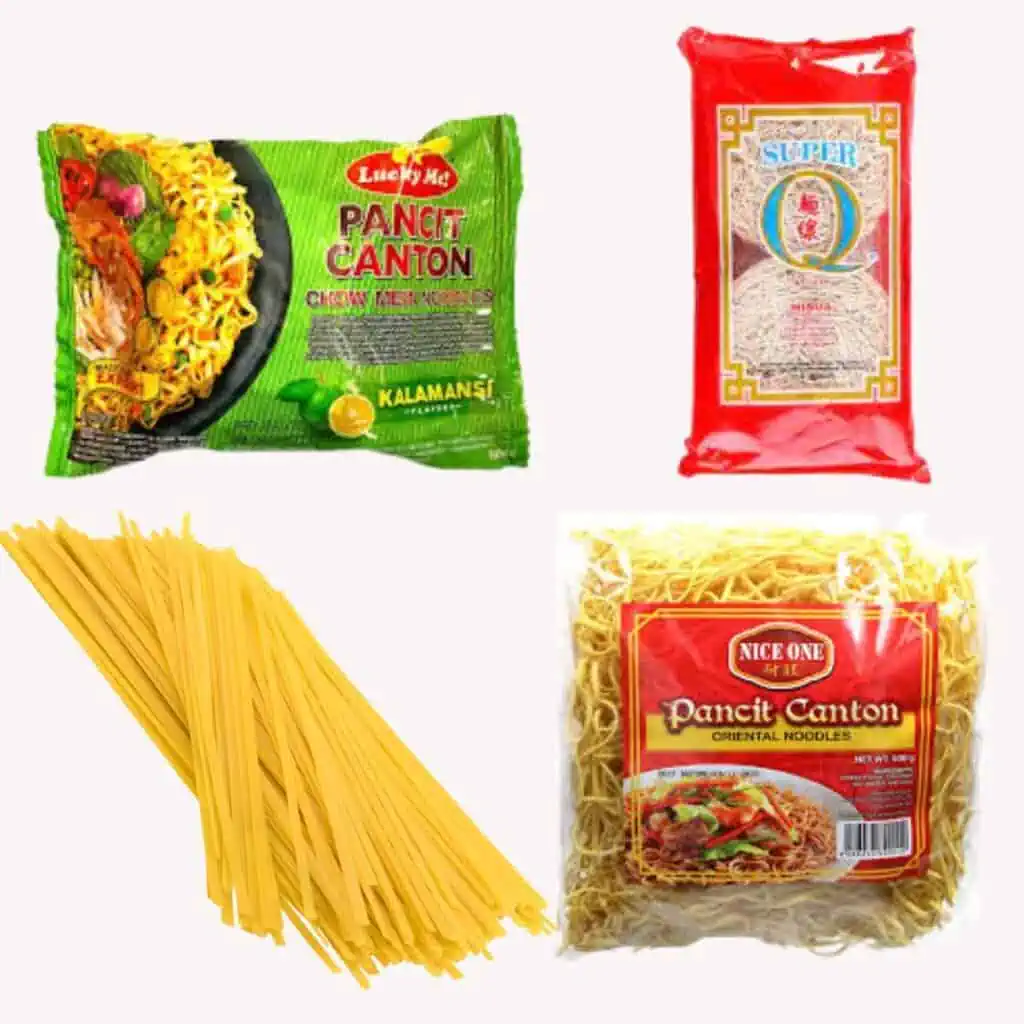
Noodles play a significant role in Filipino cuisine, with various types and styles being used in different dishes. Pancit, the Filipino version of noodles, comes in many varieties such as pancit canton, pancit bihon, and pancit palabok. These noodles are often stir-fried with vegetables, meat, and flavorful sauces, creating a delicious and satisfying meal.
Popular instant noodles in the Philippines: Lucky Me, Nissin, Payless
Healthier noodles are: shirataki noodles, rice noodles, Misua, Veggie noodles, Mr. Ube Fresh noodles, Gluten-free chia pasta
Pro Tip:
When cooking pancit noodles, follow the package instructions for the recommended cooking time. Overcooking can result in mushy noodles, while undercooking can leave them too firm.
10. Calamansi: The Citrus Wonder
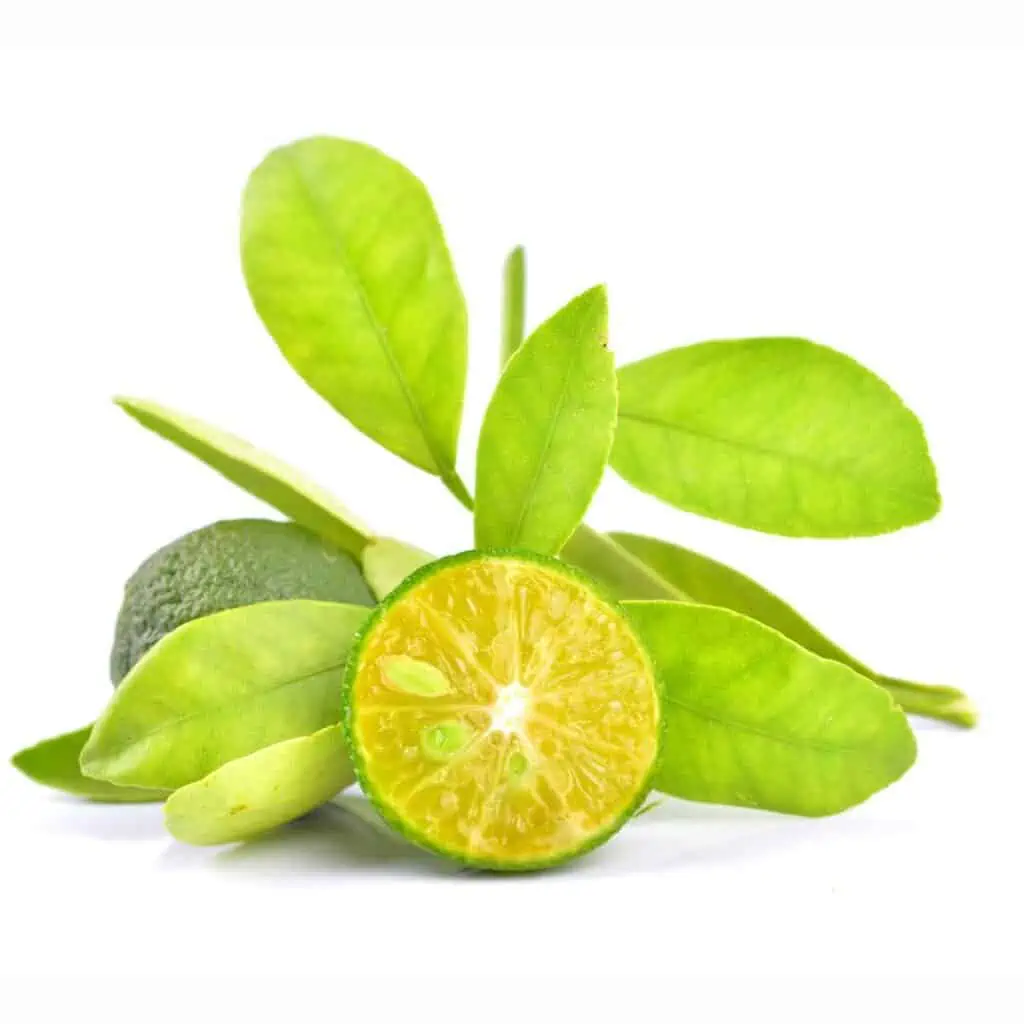
Calamansi, also known as Philippine lime, is a small citrus fruit that plays a vital role in Filipino cuisine. It has a tart and tangy flavor, similar to a combination of lemon and lime. Calamansi is used as a condiment, marinade ingredient, and flavor enhancer in a wide range of Filipino dishes.
Fun Fact:
Calamansi is a versatile fruit that can be used in both savory and sweet dishes. It is a popular choice for making refreshing drinks, like calamansi juice, and is often squeezed over grilled meats and seafood for a burst of citrusy goodness.
Looking for a Detailed List of Essential Pantry Ingredients?
If you’re eager to stock your pantry with a comprehensive array of essential ingredients for Filipino cooking, we’ve got you covered! Here is a more detailed list of pantry essentials that will help you unleash your culinary creativity and prepare authentic Filipino dishes that will impress your taste buds and those of your loved ones.

BASIC
- Cooking oil
- Butter
- Margarine
- Eggs
- White rice
- Salt and pepper
- Canned goods
- Biscuits and crackers (Skyflakes)
- Dried noodles
- Coffee (3 in 1)
- Cocoa
- Iced tea
- All purpose flour
- Coconut milk
- Onion, garlic, ginger
- Shrimp paste
- Sauces or Sawsawan
- Bread
- Sausages- Ham, Bacon, hotdog, tapa, longganisa, tocino
SPICES & HERBS
- Annatto seeds (Atsuete)
- Bay Leaves
- Black Pepper
- Dried Chili Peppers
- Ginger
- Turmeric
- Yellow and Red onion
- Safflower (Kasubha)
- Red chili (siling labuyo)
- Green chili (siling haba)
- Cinnamon
- Star anise
- Curry powder
- Sea salt
BREAD SPREAD
- Lily’s Peanut butter
- Cheese whiz
- Coco jam
- Liver spread
- Lady’s choice spread
- Queso
SOUR AGENTS
- Tamarind
- Calamansi
- Kamias
- Tomato
- Green mango
- Vinegar
- Key lime (dayap)
- Pineapple
- Sinigang Mix
SAUCES OR SAWSAWAN
- Soy Sauce (Toyo)
- Fish Sauce (Patis)
- Shrimp Paste (Bagoong)
- Vinegar (Suka)
- Oyster Sauce
- Banana Ketchup
- Tomato ketchup
- Tomato sauce
- Toyomansi
- Lechon gravy such as Mang Tomas
- BBQ sauce
FERMENTED ITEMS
- Bagoong Alamang
- Atchara
- Burong Mangga
- Burong kanin + fish/+shrimp/+pork
- Miso paste
- Fermented crab paste
- Anchovy paste
- Fermented black beans (tausi)
- Sweet – kaong, nata de coco
- Pickled relish (cucumber)
- Salted egg
SWEETENERS
- White sugar
- Brown Sugar
- Coconut Sugar
- Condensed Milk
- Muscovado Sugar
- Wild honey
- Panutsa de bao
- Stevia
CANNED ITEMS
- Coconut Milk
- Sardines
- Corned Beef/Tuna
- Evaporated Milk
- Condensed milk
- Spam
- Luncheon meat
- Liver spread
- Sausages
- Vegetables such as Corn, tomato, green peas, mushroom
DRIED ITEMS
- Dried Anchovies
- Dried Shrimp
- Dried Squid
- Dried Mangoes/Banana
- Dried fish
- Dried ear wood mushroom (Tenga ng daga)
- Oatmeal
- Cereals
- Dessicated coconut
- Bread crumbs
- Tapioca balls
- Broth cubes
- Cassava flour
- Cornstarch
- All purpose flour
- Rice flour
- Cocoa powder
- Ube powder
- Baking powder
- Baking soda
- Glutinous rice and powder
- Magic sarap
NOODLES & WRAPPERS
- Pancit Canton
- Pancit Bihon
- Rice vermicelli
- Miki
- Sotanghon
- Lomi
- Misua
- Spaghetti noodles
- Elbow macaroni
- Instant noodles
- Molo wrappers
- Lumpia Wrappers
FRESH PRODUCE
- Kangkong
- Kamote tops
- Dahon ng sili
- Moringa (Malunggay)
- Chayote (Sayote)
- Okra
- Eggplant
- Gourd-Bitter, Ridge, Bottle, Sponge
- Pechay
- Cabbage
- Banana heart
- Bamboo shoots
- Tomato
- Pumpkin
- Carrot
- Potato
- Bell pepper
- Cauliflower
- Broccoli
- Cucumber
- Corn
- Jicama (singkamas)
- Taro
- Sweet potato
- Purple yam (ube)
- Cassava
- Radish
BEANS & LEGUMES
- Mung Beans
- Black Beans
- Chickpeas
- Lima Beans
- Kidney Beans
- Long beans (sitaw)
- Winged beans (sigarilyas)
- Sweet pea (chicharo)
- Baguio beans
By referring to this detailed list, you can ensure that your pantry is fully stocked with all the necessary ingredients to whip up delicious and authentic Filipino dishes. From aromatic herbs and spices to versatile beans, souring agents, condiments, fermented items, sweeteners, canned items, dried items, and noodles and wrappers, you’ll have everything you need to embark on a flavorful culinary journey.
So, what are you waiting for? Stock up your pantry with these essential ingredients and get ready to create mouthwatering Filipino dishes that will transport your taste buds to the vibrant flavors of the Philippines!
FAQs about Pantry Ingredients in the Philippines
Q1: Where can I find these essential pantry ingredients of the Philippines?
You can find these essential pantry ingredients in most grocery stores and supermarkets across the Philippines. They are widely available and often come in different brands and variations. Look for trusted local brands like Datu Puti, Silver Swan, and UFC for quality and authenticity.
Q2: Can I substitute ingredients if I can’t find them?
Yes, you can make substitutions based on availability and personal preference. However, keep in mind that substitutions may alter the taste and authenticity of the dish. For example, if you can’t find coconut milk, you can use coconut cream diluted with water as a substitute, but the flavor may be slightly different.
Q3: How long do these pantry ingredients typically last?
The shelf life of pantry ingredients varies depending on the specific ingredient and how it is stored. Rice can last for months or even years if properly stored in an airtight container. Vinegar, soy sauce, and fish sauce have a longer shelf life due to their acidic nature. It’s best to check the expiration dates and storage recommendations on the packaging.
Q4: Are these pantry ingredients expensive?
The cost of pantry ingredients in the Philippines can vary depending on the brand and quality. Generally, rice, vinegar, soy sauce, and fish sauce are affordable and readily available. Coconut milk and premium soy sauce may be slightly more expensive, but they are worth the investment for the enhanced flavor they provide.
Q5: Can these pantry ingredients be used in non-Filipino recipes?
Absolutely! While these pantry ingredients are commonly used in Filipino cuisine, they can also be incorporated into various international recipes. Coconut milk can add richness to curries and soups, soy sauce can enhance stir-fries, and vinegar can be used in dressings and marinades. Don’t be afraid to experiment and unleash your culinary creativity!
Q6: Are there any health benefits to using these pantry ingredients?
Yes, many of these pantry ingredients offer health benefits. Garlic, for example, is known for its antimicrobial properties and potential immune-boosting effects. Coconut milk contains medium-chain triglycerides (MCTs), which are believed to provide energy and support weight loss. However, moderation is key, as some ingredients like soy sauce, MSG, and fish sauce are high in sodium.
Conclusion
Stocking up your pantry with essential ingredients is the first step to mastering Filipino cooking. Rice, coconut milk, vinegar, soy sauce, fish sauce, and garlic are just a few of the must-have ingredients that will bring the flavors of the Philippines to your dishes. With these ingredients at hand, you can create a wide array of authentic Filipino recipes that will transport your taste buds to the beautiful islands of the Philippines.
So what are you waiting for? Start stocking up your pantry with these essential ingredients and embark on a culinary adventure filled with delicious Filipino flavors!

